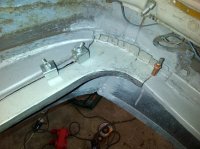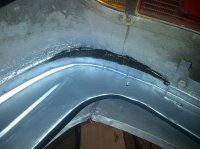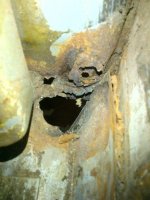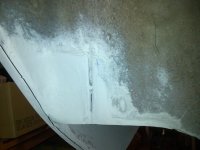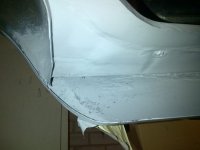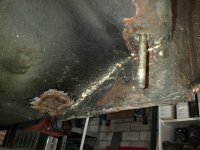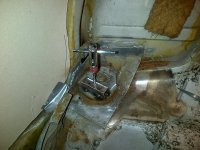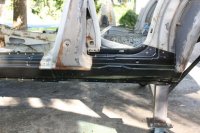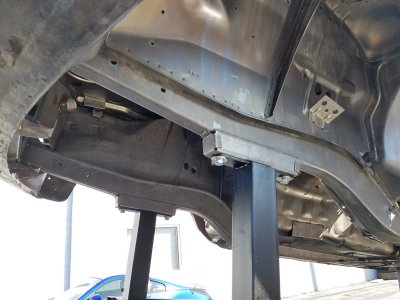Being new to car restauration i'd thought it would be good to learn from the collective knowledge of the forum. That, and the fact that my love for the car superseeded reasonable thinking makes it essential. I'm technical, but haven't restored anything with wheels yet...
So to prevent that this car will be the barnfind of 2048, let me invite you to support me to hack my way through the brittle brown stuff.
Let me open this thread to show you what i've done, and what i plan to do.
I am first of all looking for comments how i could improve my work. And, please, do not hold back.
Being Dutch, were known for being direct. You can be direct with me and i'll be thankfull for the clarity of your comment.
So the history;
I wanted a classic since i was 12 or so; I collected every book there was on 1920-1980 cars that i could find. In 1996 I started with a old german '69 moped, and later i saved up some money but never really made the move to buy something.
So, when my Wife and I discovered in 2009 that soon there would be more then just the 2 of us, my friends advised me to spend the saved pennies before it was confiscated "for baby essentials"...:???:
So after fantasizing for >ten years where i would spend my (little) money on, i had to decide in a few weeks how the black bac account numbers had to materialise...
- I loved enlish cars, but dreaded their build quality
- being a technician, i loved the robust german engineering of my 1969 moped
- and being very precise, complex technical mechanisms such as the Zeniths carbs are considered kitchen table heaven by me...
What did i know about bodywork? .....not much other then that e9's were rust prone.
So i choose this car; a 1973 3.0 CS, Swiss delivered, fjord blue, tan leather. It was already torn apart once and seems (i'm not sure) to have at least the front fenders replaced, and the interior was complete, although a tear here and there was present. 99% of the parts were present.
I hoped that this would prove a a good start.
It was; 2,5 years of driving; about 10.000 km's (~7500 miles) and using it as a daily driver. (but not in winter; I took my bicycle through the snow to work instead of her; i learned that much already by reading the forum). The biggest problem's I've had were dead batteries and loose screws.
I love it, and so do the wife and 2 kids (by now)
Into the project;
Rebuilt the alternator and distributor (thanks to DeQuincey) in the meantime, and did some general tiding up. Fiddeled with the carbs (only a bit, they still have me puzzled on their inner workings). And i've been driving it... A lot.
This winter (2011) i decided to solve the rust issue in the rear floor sections around the rear axle attachement points under the rear seat.
I needed to learn to weld, buy all the stuff required, tools, lifting device, sandblasting cabinet, sheet metal working bits etc. So it has taken some time to get going.
I'll limit myself firstly to parts of the car that are not in the line of sight, trying to keep the metallic blue on the car where i can, as i believe it requires more skills then i currently have to cut & weld and get a e9 worthy paint job, all by doing it yourself. (This may not proove to be a wise thing?)
I started with the area around the fuel tank, the previous owner repaired it quite bad.
I made replacement sections for the area that i considered to be bad enough to replace. The weld is not completely flat after grinding it down, but i accepted it.
And it is is not spotwelded to the rear valence (isn't that what the panel is called that holds the rear lights and licence plate?), but it's sealed.
Attached some pictures showing the steps.
Tell me all you think; I'm eager to learn.
So to prevent that this car will be the barnfind of 2048, let me invite you to support me to hack my way through the brittle brown stuff.
Let me open this thread to show you what i've done, and what i plan to do.
I am first of all looking for comments how i could improve my work. And, please, do not hold back.
Being Dutch, were known for being direct. You can be direct with me and i'll be thankfull for the clarity of your comment.
So the history;
I wanted a classic since i was 12 or so; I collected every book there was on 1920-1980 cars that i could find. In 1996 I started with a old german '69 moped, and later i saved up some money but never really made the move to buy something.
So, when my Wife and I discovered in 2009 that soon there would be more then just the 2 of us, my friends advised me to spend the saved pennies before it was confiscated "for baby essentials"...:???:
So after fantasizing for >ten years where i would spend my (little) money on, i had to decide in a few weeks how the black bac account numbers had to materialise...
- I loved enlish cars, but dreaded their build quality
- being a technician, i loved the robust german engineering of my 1969 moped
- and being very precise, complex technical mechanisms such as the Zeniths carbs are considered kitchen table heaven by me...
What did i know about bodywork? .....not much other then that e9's were rust prone.
So i choose this car; a 1973 3.0 CS, Swiss delivered, fjord blue, tan leather. It was already torn apart once and seems (i'm not sure) to have at least the front fenders replaced, and the interior was complete, although a tear here and there was present. 99% of the parts were present.
I hoped that this would prove a a good start.
It was; 2,5 years of driving; about 10.000 km's (~7500 miles) and using it as a daily driver. (but not in winter; I took my bicycle through the snow to work instead of her; i learned that much already by reading the forum). The biggest problem's I've had were dead batteries and loose screws.
I love it, and so do the wife and 2 kids (by now)
Into the project;
Rebuilt the alternator and distributor (thanks to DeQuincey) in the meantime, and did some general tiding up. Fiddeled with the carbs (only a bit, they still have me puzzled on their inner workings). And i've been driving it... A lot.
This winter (2011) i decided to solve the rust issue in the rear floor sections around the rear axle attachement points under the rear seat.
I needed to learn to weld, buy all the stuff required, tools, lifting device, sandblasting cabinet, sheet metal working bits etc. So it has taken some time to get going.
I'll limit myself firstly to parts of the car that are not in the line of sight, trying to keep the metallic blue on the car where i can, as i believe it requires more skills then i currently have to cut & weld and get a e9 worthy paint job, all by doing it yourself. (This may not proove to be a wise thing?)
I started with the area around the fuel tank, the previous owner repaired it quite bad.
I made replacement sections for the area that i considered to be bad enough to replace. The weld is not completely flat after grinding it down, but i accepted it.
And it is is not spotwelded to the rear valence (isn't that what the panel is called that holds the rear lights and licence plate?), but it's sealed.
Attached some pictures showing the steps.
Tell me all you think; I'm eager to learn.


